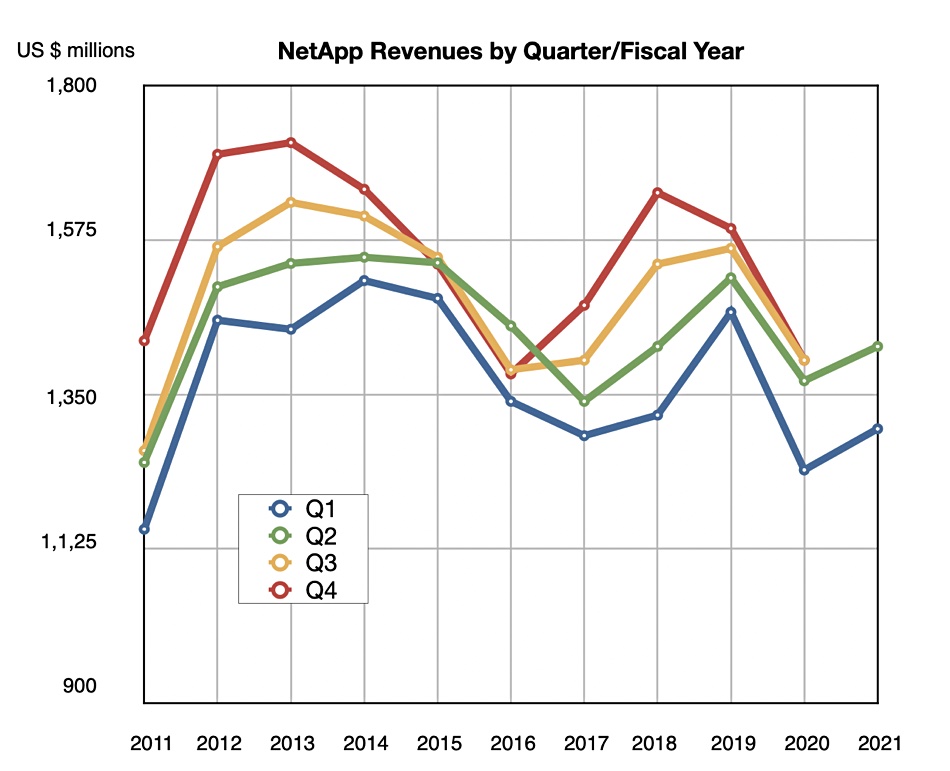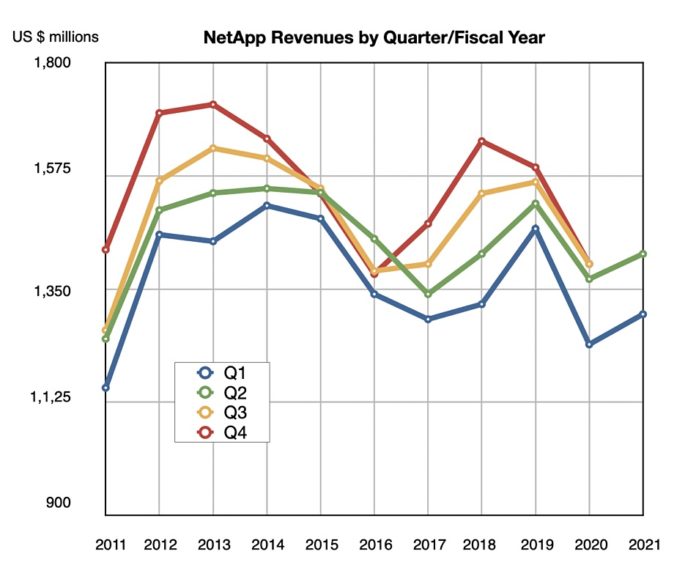NetApp has posted its second successive quarter of revenue growth, thanks to an unexpected boost in high-end all-flash storage array sales.
The company recorded $1.42bn in revenues for the second fiscal 2021 quarter ended October 30, 2020,three per cent higher than a year ago and above guidance. Net income fell 43.6 per cent to $137m.
CEO George Kurian’s said in a press statement: “I am pleased with our continued progress in an uncertain market environment. The improvements we made to sales coverage in FY20 and our tight focus on execution against our biggest opportunities continue to pay off.”

Highlights in the quarter included a 200 per cent jump in public cloud services annual recurring revenue (ARR) to $216m, and all-flash array run rate increasing 15 per cent to $2.5bn. NetApp said 26 per cent of its installed systems are all-flash, which leaves plenty of room to convert more customers to AFA systems.
Hardware accounted for $332m of the $749m product revenue, down 18 per cent Y/Y, with software contributing $417m, up 14 per cent. Product revenue in total declined three per cent Y/Y.
On the earnings call, CFO Mike Berry said the company is “on track to deliver on our commitment of $250m to $300m in fiscal ’21 Cloud ARR and remain confident in our ability to eclipse $1bn in Cloud ARR in fiscal ’25.”
The outlook for NetApp’s Q3 is $1.42bn at the mid-point, one per cent up on the same time last year. NetApp hopes that Covid-19 vaccination programs will lead the overall economy to growth after that in calendar 2021.
NetApp gives PowerStore a kicking
Kurian’s prepared remarks included this sentiment: ”We are pleased with the mix of new cloud services customers and growth at existing customers. We saw continued success with our Run-to-NetApp competitive takeout program, an important component of our strategy to gain new customers and win new workloads at existing customers.”
That program targets competitors’ product transitions, such as Dell’s Unity to PowerStore transition. Dell bosses recently expressed impatience about PowerStore’s revenue growth rate in its quarterly results.
Kurian talked about market share gains in the earnings call: “If you look at the results of all of our major competitors, [indiscernible], Dell, and HP, there’s no question we have taken share. I think our product portfolio is the best in the market.” He called out high-end AFAs as doing well – which was unexpected according to Berry. This drove NetApp’s “outperformance in product revenue and product margin”.
Kurian gave PowerStore a kicking when replying to an analyst’s question: “I think as not only we have observed, but many of our competitors have also observed, the midrange from Dell has not met expectations. It is an incomplete product. It is hard to build a new midrange system. And so it’s going to be some time before they can mature that and make that a real system. And you bet we intend to take share from them during that transition… We’re going to pour it on.”
Riding the disk replacement wave
NetApp’s AFA revenue growth should continue, according to Kurian. “We think that there are more technologies coming online over the next 18 to 24 months that will move more and more of the disk-based market to the all-flash market. We don’t think that all of the disk-based market moves to all-flash. But as we said, a substantial percentage of the total storage market, meaning let’s say 70 to 80 per cent will be an all-flash array portfolio.”
He is thinking of QLC flash (4bits/cell) SSDs as they enable replacement of nearline and faster disk drives. Kurian said: “QLC makes the advantage of an all-flash array relative to a 10k performance drive even better. So today, there are customers buying all-flash arrays, when they are roughly three times the cost of a hard drive. With QLC, that number gets a lot closer to one and a half to two times.”
Also, the “economics of all-flash are benefited by using software-based data management”.








